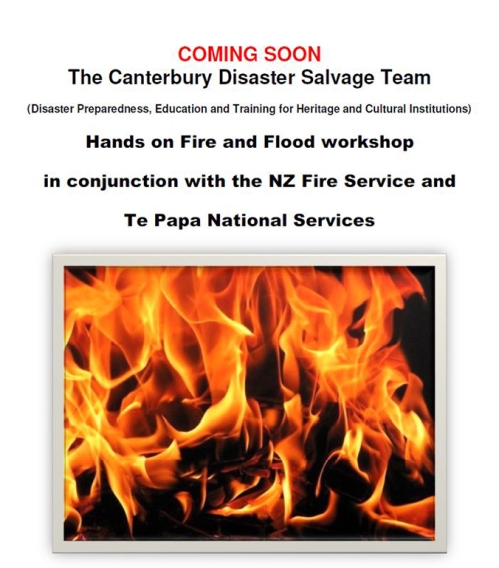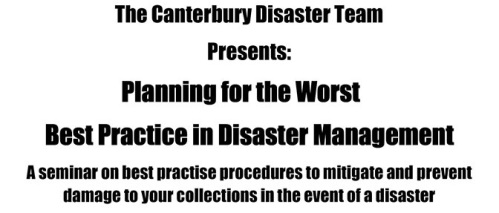- View the draft Programme DST 2017
- If you wish to register for the seminar please contact Lyn Campbell.
- Cost : $75.00 per person.
Tag Archives: Workshops
Seminar : Disaster management, draft programme
Coming soon : Fire & flood workshop

- For more information see the Draft programme [PDF, 500 KB]
- Application form [Word document]
Filed under Learning, News release, Training
What’s Happening in December 2012 | National Services Te Paerangi
Read the full newsletter: What’s Happening in December 2012 | National Services Te Paerangi
Following are some items of interest from the newsletter, including advice on labelling photographs, a list of recipients of Helping Hand grants (some local names!), Techsoup offers of technology, upcoming workshops, and museums on the West Coast.

Advice from the helpline – how to label photographs
Recently we received an enquiry about best practice for labelling photographs. We asked Anita Hogan, Collection Manager Photography and New Media Art at Te Papa, how she would do it. This is what she suggested:
Always use a pencil for marking photographs, as inks can eventually ‘strike through’ the paper and show on the front. This might take years, but you can occasionally see it when a photographer has written on the back of their own work. Adhesive labels can also stain the front of the photograph, so try to avoid sticking a label to the back of the photograph and writing on it.
Update on Helping Hands Grants
A helping hand for footpath signage, korowai storage, and a Summit Station diorama
In this quarter, NSTP has awarded funding for korowai storage boxes, a diorama enclosure, and footpath signage, through the Helping Hands Grant programme. We have granted more than $17000 to small museums, galleries, and iwi groups since the beginning of the financial year in July.
The Helping Hands Grant is available to small museums that need a hand with carrying out their responsibilities. It can be used to obtain materials, services, and information, or to support projects up to a maximum of $1000.
Grants have recently been awarded to the following organisations:
- Ashburton Museum – travel assistance to attend the SCS 4.0 Seminar for museum professionals
- Otaua Marae – materials for acid-free boxing for six korowai
- Anderson Park Art Gallery – travel assistance to attend the Museum and Gallery Marketing Forum
- Opotiki Heritage and Agriculture Museum Charitable Trust – funding for conservation materials
- Fell Locomotive Museum – assistance with creating a secure enclosure for a detailed diorama of Summit Station and surrounding landscape
- Port Chalmers Historical Society – help to establish new office
- Katikati Heritage Museum Society – funding for publicity materials for the museum, including rack cards and business cards
- Akaroa Museum – design and production of three footpath signs to carry interpretation about Akaroa’s heritage buildings.
If you have a small project which needs a funding boost, check out the Helping Hands Grant criteria on the NSTP website (some restrictions apply).
What’s Happening in November 2012 | National Services Te Paerangi
Read the full newsletter [PDF]: What’s Happening in November 2012 | National Services Te Paerangi
Following are some items of interest from the newsletter, including information about museum marketing, grants for small museums, a stolen vase, and upcoming workshops.

Museum & Gallery Marketing Forum
From 18 to 19 October, marketing staff from museums and galleries all over New Zealand gathered in Wellington for the inaugural Museum & Gallery Marketing Forum. It was a great two days of sharing ideas and making new contacts, culminating in a tour of some of central Wellington’s museums.We are now working through steps to make the forum a regular event.
NSTP services survey
Thank you for your feedback on our last survey, which was about our grants programme. We were pleased to discover that those of you working in small museums found the Helping Hands Grant particularly useful. We’re reviewing our grants programme at the moment and will tell you about changes in the next few months.
For now:
Vase stolen from Alberton
 This vase is believed to have been stolen from Alberton, Mt Albert, Auckland, some time between 30 August and 19 October 2012. It is approximately 28cm tall, with ‘3 / 938/492’ marked on the base, and the accession number label XAH.Y.53.
This vase is believed to have been stolen from Alberton, Mt Albert, Auckland, some time between 30 August and 19 October 2012. It is approximately 28cm tall, with ‘3 / 938/492’ marked on the base, and the accession number label XAH.Y.53.
NZ Historic Places Trust would be very grateful if you could keep an eye out for the vase, and spread the word to any relevant networks you may have. If you have any information which could assist in its recovery, please contact Rebecca Apperley on 04 472 4341.
Upcoming workshops
Māori in Museums
22–23 November, Air Force Museum, Christchurch
Care and identification of photographs
Auckland
4–5 & 7–8 February 2013, Central City Library, Auckland
Wellington
18–21 February 2013, Te Papa, Wellington
Filed under Contacts, Learning, Newsletter
Paper mending workshop
I was privileged to be able to attend the above workshop run by Lynn Campbell the Paper Conservator at the Christchurch Art Gallery.
Heres an overview of a most enjoyable morning:
IMPORTANT: You must be able to reverse your repair, i.e. don’t use anything that you cannot remove such as pva, cellotape, even book tape apparently.
CLEANERS Commercial draught cleaners used to clean paper are expensive so the alternative is to use a grated rubber (non-abrasive such as Pelican White) which is rubbed, using clean fingers or cotton wool etc., over the area to be mended. Note: don’t rub over pencil, chalk, pastels etc. Please note that papers made in Asia will be damaged by this method due to the fibres.
PAPER TYPES European paper can be easily cleaned by the rubber method, however the method used to make this paper is quick, produces acidic paper, the fibres are shorter and therefore don’t make strong patches.
Japanese paper is made from trees that are cut down then soaked for 6 months in alkaline river-fed waters. Apart from reducing acidity this method also gets rid of lignum which will eventually destroy the paper. This makes it the paper of choice for artists and printers. Therefore strong but flexible papers such as Kozo or Mulberry are ideal to use as repairers.
GLUES An excellent glue is methyl cellulose which is reversible with water. (Never buy the sodium… version). Mix with warm water – add the powder to the water not vice versa. (Don’t use metal spoon – glass cocktail stirrers are ideal, or plastic or wood). Keep refrigerated. When it goes watery or even like a plastic sheet, it has gone off.
(Wheat glue is the best but takes half a day to prepare- about 40 minutes of stirring for a start, if I remember correctly. Incidentally, in Japan the apprenticeship period for a paper repairer is 10 years. The first year is spent stirring and making the glue and the second is tearing paper. At the end of the apprenticeship they are given a large bucket of the glue which means they never have to make it again).
METHOD After cleaning area to be mended, lay item on a “light-box” table if available. Overlay with a mylar and then your mending paper. Using a fine paintbrush dipped in water, paint around the outline of the damaged area onto the mending paper, to make the patch. The mylar will keep the original dry. (Wet paper loses 80% of its strength and hence easier to tear). Tear out the shape of the patch – dont cut it. This means that the fibres will then grab on to the paper better. (There are special water pens you can buy – they look like a pen, have a brush on the end, and you unscrew and pour water in).
Paste the patch, flicking the glue across to draw out the fibres for a better “grab”. Now glue paper together. Note” if there is a long tear, just use small pieces not one long piece.
On top of the mended area lay Mono baking paper (cheapest and best). Run a wooden spatula over the area to flatten, then dry by either running a hot spatula iron over or putting weights (such as bags filled with lead shot) on top and leave for half a day. If repairing a number of items you can pile them up, with baking paper between, and top with the weights.
Sue Julian
Macmillan Brown Library, University of Canterbury
Filed under Learning
Oral History Workshops
 The Oral History Centre of the Alexander Turnbull Library is offering workshops for people considering using oral history in their work, community or personal projects. The workshops are taught by Judith Fyfe, lawyer and oral historian, and held in the National Library Building, Aitken Street, Wellington.
The Oral History Centre of the Alexander Turnbull Library is offering workshops for people considering using oral history in their work, community or personal projects. The workshops are taught by Judith Fyfe, lawyer and oral historian, and held in the National Library Building, Aitken Street, Wellington.
The Essentials of Oral History Research
This is a two day course. For anyone undertaking an oral history project we recommend attending both days.
Day One: Introduction to Oral History
Saturday, 20 September 2008, 8.45am-4.30pm
An introduction to oral history methodology. How to plan an oral history project, choose the best equipment, achieve clear audio recordings, select informants, follow ethical procedures, develop questioning techniques, process oral history and make the material available for use. Bring a recorder if you have one you intend to use for recording. Exercises to be completed before Day Two will be discussed. Fee: $150 ($110) Limit: 14
Day Two: Recording Seriously
Saturday, 18 October 2008, 8.45am-4.30pm
Recording Seriously builds on Day One: Introduction to Oral History, reviewing work completed and covering in more detail interview techniques, project planning and technical, ethical, and legal issues. Some experience in recording or processing oral history is necessary. Completion of an earlier Essentials course or a recent equivalent introductory course is required. Fee: $150 ($110) Limit: 14
For further information concerning registration or funding, contact the Oral History Centre,
04-474 3162 or atl@natlib.govt.nz
Filed under Learning

